July 2012 Archives
We quite often give advice on the safest storage methods for coins and banknotes. So I guess this is the ultimate "what not to do!!"
Have a read of this ninemsn news story and chuckle as we did.
I received my August issue of the Australasian Coin and Banknote Magazine in the mail today and with interest turned to the Letters to the Editor. Each month Steele Waterman of Watermans Coins and Banknotes replies to letters or emails sent in to CAB asking for information or sharing their reader knowledge.
This month brings an interesting letter from reader Ken who claims and has provided a photo to prove that he's found a 2012 proof set with a 2013 dated coin! This will have collectors rushing to check their proof sets to see if they too have been lucky enough to happen upon an error set.
Ken purchased his 2012 proof set from the Geelong post office and after he'd inspected it he realised a major mistake had occured at the mint. Ken reminds us that we've seen before 1985 10c pieces in 1986 mint sets and these sets today realise a hefty premium over a regular set although the mint set packaging is not tamper proof. The proof sets are more secure however with a tough plastic casing so it's not thought that this new error set has been unscrupulously manufactured. It's been a simple mistake in packaging up the sets at the Royal Australian Mint. I recall my trip to the Mint in March this year where they were in fact minting the proof coins for 2013 already. I was asked not to look at those coins as they were under embago.
This set is of interest, as Ken says in that it's a set with a mixed up coin of a future year which I don't think we've ever seen before. It's always been a past coin. McDonald's 2012 (19th Edition) also suggests that 1996 proof sets have been found with a 1995 5c and 1991 proof sets with a 1990 10c. The most interesting error set I believe is the 2006 proof set with the 2005 mob of roos dollar as this coin was not issued and the error set (of which approx. 40 are known) is the only way to obtain a 2005 proof mob of roos $1.
If the 2013 coin in this 2012 error set is a mob of roos dollar (it's not entirely clear in the letter, but it's assumed) and that dollar type isn't included in the 2013 proof set then this coin might be a true rarity indeed. Are there any more out there?
Note: Subscribers to CAB receive their magazine a little bit earlier than they are usually found in newsagents. It's cheaper to subscribe too! Email auscoinbank@bigpond.com for details or to send your letters to the editor.
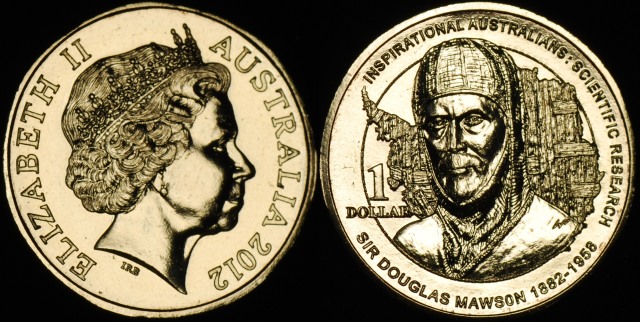
2012 Sir Douglas Mawson $1
This Sir Douglas Mawson one dollar coin released by the Royal Australian Mint is a tribute to the life's work of this courageous geologist and explorer. He led the Australian Antarctic expedition in 1911 and was a pioneer in Antarctic exploration and scientific study. He died in 1958 at the age of 76. You may remember him as the face on the Australian paper $100 note!
This is the fifth coin in the Inspirational Australians series which has seen a coin released each year since 2008. Other inspirational Australians depicted are Dame Joan Sutherland in 2011, Fred Hollows in 2010, Steve Irwin in 2009 and Saint Mary MacKillop in 2008. These 25mm aluminium bronze one dollar coins are collector coins only but are the same as their circulating cousins in all specifications.
The Sir Douglas Mawson reverse is sculpted by RAM designer Wojciech Pietranik, his WP initials can be seen on the design. It depicts Mawson in front of a map of the Antarctic territory. The legends reads "Inspirational Australians: Scientific Research Sir Douglas Mawson 1882-1958 1 Dollar". The obverse features Queen Elizabeth II depicted by Ian Rank-Broadley. It's issued in a collector card for $13.50, find the mintage in the 2012 mintages table.
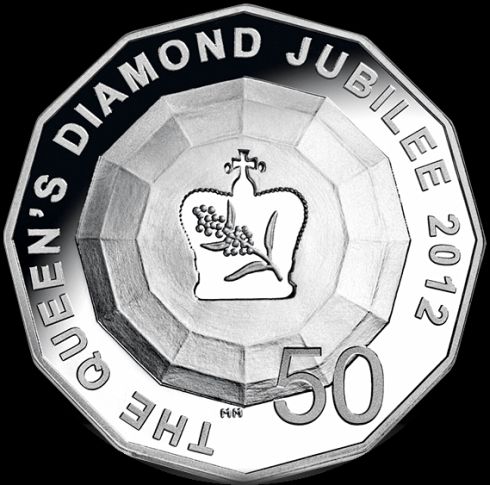
2012 Queen's Diamond Jubilee Silver Proof 50c
Hardcore fifty cent collectors will have to open their wallets wide to secure one of these silver 50c issued only in a 3 coin set. Struck in 99.99% pure silver this 50 cent is issued to commemorate the Queen's Diamond Jubilee and is not to be confused with the Stuart Devlin designed Australian 50c in cupro nickel. Released jointly with the Queen's Royal Mint's of the Commonwealth, the Royal Australian Mint, the Royal Canadian Mint and the Royal Mint it's a collector set only for those serious 50c collectors.
The reverse design is by Australia's Michael Meszaros and depicts a raised diamond with a crown at the centre and a sprig of wattle. The legends read "The Queen's Diamond Jubilee 2012". The obverse features the Ian Rank-Broadley effigy of Queen Elizabeth II.
This silver set has a worldwide mintage of 4,000 sets with an Australian issue price of $522.50. For those with the deepest pockets then the gold set might interest you with a worldwide mintage of just 375 sets at a cost of $10,118.90.
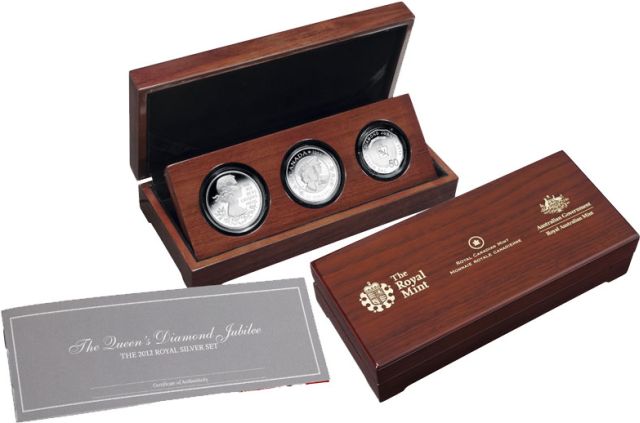
2012 Queen's Diamond Jubilee Silver Set (50c on the right) (image courtesy www.ramint.gov.au)
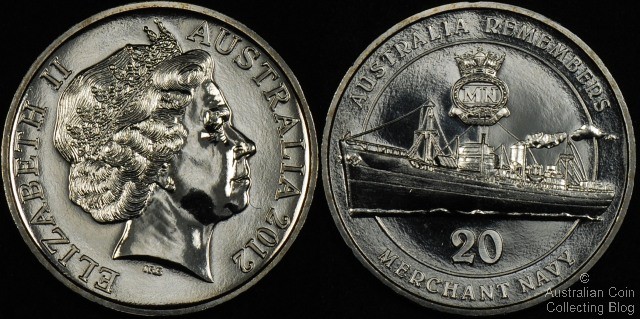
2012 Merchant Navy 20c
The Australia Remembers series of NCLT 20c continues with a fourth release coin in 2012. Previously in this series we've seen the 2011 War Historians 20c, 2010 Lost Soldiers of Fromelles 20c, PNC and 2009 Service Nurses 20c. This series recognises and celebrates those people who made history beyond the battlefields.
The 2012 twenty cent remembers and pays tribute to the Merchant mariners, the lifeline for transporting essential supplies through times of war and peace. During WWII the Merchant Navy suffered a higher rate of casualties than the armed forces and it's this courage and commitment we honour with memorials, service medals and now this 20c coin.
The image depicted on the reverse of the coin sculpted by the Royal Australian Mints' Wojciech Pietranik is inspired by the vessel SS River Loddon, Australia's first merchant ship.
The obverse of the coin depicts the standard Ian Rank-Broadley image of HM Queen Elizabeth II. This 20c is released as non-circulating legal tender (NCLT) and is housed in a capsule in an informative card. The card design features red Flanders Poppies, an important symbol of remembrance
Issued for $8 this uncirculated 11.3g 28.52mm cupro nickel 20c will not be found in your change.
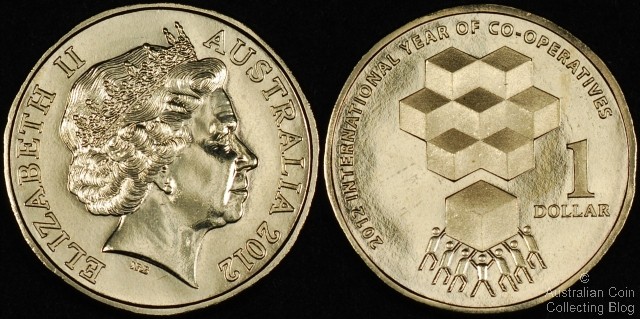
2012 International Year of Cooperatives

2012 International Year of Co-operatives One Dollar in PNC
The International Year of Co-operatives one dollar features in this Australia Post PNC limited to 15,000 issued. Minted by the Royal Australian Mint the coin and its' theme raise awareness of the importance of the co-operative business structure in society. The role of commemorative coins is to share these types of events and be reminded of their significance when we see one in change. This coin won't be found in change, it has been minted purely as a collector piece, known as NCLT (non-circulating legal tender).
The Australia Post PNC features a 60c stamp and the commemorative one dollar coin and was issued for $19.95. Each PNC is individually numbered.
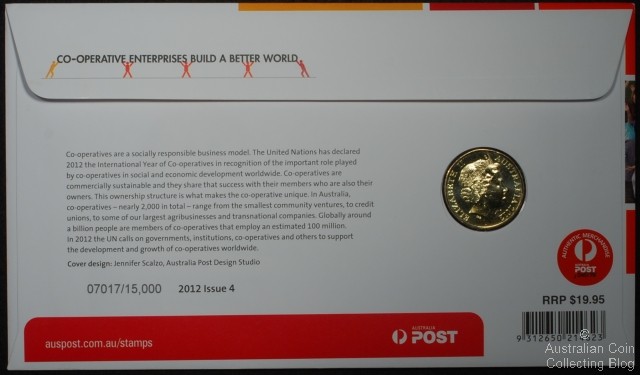
2012 International Year of Co-operatives One Dollar in PNC
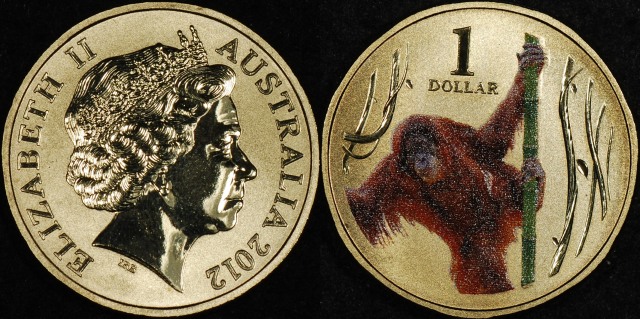
2012 Orang-utan $1
This Orang-utan one dollar is issued by the Royal Australian Mint as part of the 6 coin Animals of the Zoo series. Celebrating the 150th anniversary of the Melbourne Zoo (the oldest zoo in Australia) the series showcases rare and endangered animals who call Melbourne Zoo home.
This coloured dollar is the last coin released in this series and features the critically endangered Sumatran Orang-utan. Their habitat dwindles due to extensive logging and palm oil plantations. They are also hunted for the pet trade. Sumatran Orang-utans stand 1.25-1.5m tall and share 97% of our DNA. They dwell high up in the rainforest canopy foraging for fruits and building nests out of leaves and branches. They rarely come to the ground and live a solitary life.
The Animals of the Zoo series follows on from the very popular Ocean, Land and Air series released by the Mint in previous years. These 25mm dollar coins have a frosted uncirculated finish, this one with a sculpted Orang-utan design which is then overlaid with colour in the pad-printing process. The design is by the RAM's Aaron Baggio. This 2012 dated one dollar weighs 9 grams and is minted on an aluminium bronze burnished blank planchet. The obverse features the standard Ian Rank-Broadley portrait of Queen Elizabeth II.
Issued in a capsule snapped into a collector card for $15, for up to date mintage figures see the 2012 One Dollar Issues and Mintages Table.
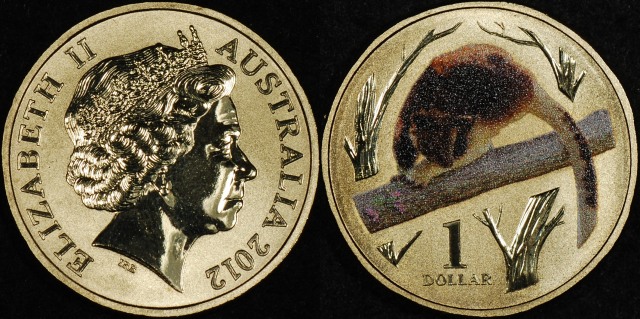
2012 Goodfellow's Tree-Kangaroo $1
The Goodfellow's Tree-Kangaroo dollar is released by the Royal Australian Mint as part of the Animals of the Zoo series. The series features 6 coloured coins all depicting rare and endangered animals residing at the zoo, this coin is in the third release. The series celebrates the 150th anniversary of the Melbourne Zoo, Australia's oldest zoo which is home to 3 of these endangered macropods. Species of the Goodfellow's Tree-Kangaroo live in mountainous rainforest areas of Papua New Guinea, Irian Jaya in Indonesia and Australia where their primary diet is the leaves of the Maple Silkwood tree. These endangered tree-kangaroos have woolly reddish brown fur with with golden yellow limbs, a long mottled golden tail and two golden yellow dorsal stripes.
The Animals of the Zoo series follows on from the very popular Ocean, Land and Air series released by the Mint in previous years. These 25mm dollar coins have a frosted uncirculated finish, this one with a sculpted Goodfellow's Tree-Kangaroo design which is then overlaid with colour in the pad-printing process. The design is by the RAM's Aaron Baggio. This 2012 dated one dollar weighs 9 grams and is minted on an aluminium bronze burnished blank planchet. The obverse features the standard Ian Rank-Broadley portrait of Queen Elizabeth II.
Issued in a capsule snapped into a collector card for $15, for up to date mintage figures see the 2012 One Dollar Issues and Mintages Table.
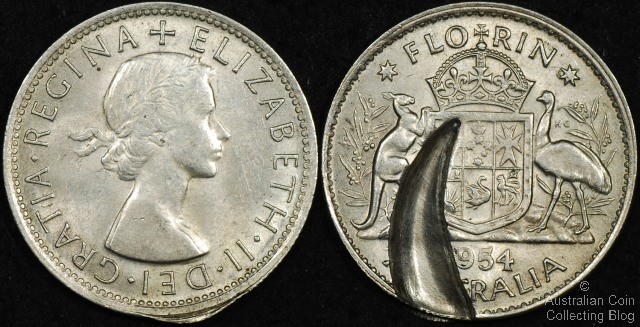
Australia 1954 Florin Struck Through Crescent Clip Blank
Above you can see a fairly unique error. It's an Australian 1954 florin that has been struck through a crescent clip blank. If you're wondering what a crescent clip blank is, it's the part of the planchet left over when an elliptical clipped planchet is formed. You can imagine a crescent clipped planchet to be the same sort of shape as the crescent moon as it is waning to a new moon or waxing away from the new moon.
This error is not only interesting because of it's scarcity, but also because it crosses the boundaries between three distinct error types. The first, the ultra scarce crescent clip blank. We've never seen one of these errors and we're only aware of one being mentioned in the literature. Second, the strike through error. Technically this coin has been struck through another unstruck coin fragment. And finally, the indent coin error. There's no denying that this coin shares many characteristics of the indent error, including the indent itself and the raised rim on the opposite side of the indented area.
Truly an interesting error coin and one that keeps us coming back to the fascinating field of error collecting!
With the rush of an ANDA show and a Downies auction a new currency determination that passed through parliament and was published on the Australian Government's ComLaw website almost slipped under the radar.
Some exciting new coins are set to be released for the collector market in 2012 and 2013. Partnering the coloured Remembrance Day commemorative $2 coin we've spoken about previously that we are sure to see in circulation later this year is a C mintmark variety.
We'll see more of the popular pad printed coloured dollars with a Polar Bear and a Rock-hopper Penguin the first in a new series for 2013. In keeping with animal themes two 1 ounce coloured silvers are set to be released. One depicts a Saltwater Crocodile "Bindi" rescued by Steve Irwin who lives at Australia Zoo and is the namesake of his only daughter. The other shows an Eastern Grey Kangaroo design by Aaron Baggio.
The mintmark one dollar for 2013 has now been set as the Bicentenary of the Holey Dollar and Dump with the usual smorgasbord of counterstamps, privymarks and c mintmark on the cards for next year. It also looks as if we'll see a series titled Australian Decimal Effigies, the first depicting the Raphael Maklouf portrait of Queen Elizabeth II used on our currency from 1985 to 1998.
It's the Centenary of Canberra in 2013 and to celebrate this a $5 silver coin is to be released as well as a commemorative copper nickel 20c. Could this be another commemorative 20c for circulation?
Revheads will be flocking for the (2013) copper nickel 50c depicting the Bathurst Endurance Race. This coin will commemorate 50 years of the 1,000km race at Mount Panorama. We'll also see a 50c for the 50th anniversary of Surfing Australia.
It will be a pleasure to see Stuart Devlin's platypus 20c design in selectively plated gold and pad printed colour in 2013. I wonder if these will be part of the proof or mint sets for 2013, the same as we saw the Coat of Arms in 2012?
Another couple of interesting possible releases is a copper nickel 20c depicting Australian Mining and an aluminium bronze dollar for the Discovery of Gold. I'm going to take a punt here and suggest that these may be released in a commemorative 2 coin set as we've seen over the last few years with the Fields of Gold Australian Wheat (2012) and Australian Wool (2011) two coins sets.
Overall an exciting bunch of new releases planned for later this year and 2013.

Melbourne ANDA Show at it's busiest. Can you spot the blog team? Photo courtesy SJS
The 7th and 8th of July 2012 saw the annual ANDA Coin and Banknote Show being held at the Caulfield Racecourse in Melbourne. We were lucky enough to attend the show on the first day and had a busy time picking through the stock of all of the dealers in attendance. Dealers present included Klaus Ford Numismatics, Universal Coin Co, JPW Coins, Waterman's Coins and Banknotes, Downies, and VP Coins. It was great to see a new face at the show, Coin Trends, who have previously been known for their mail auctions had a table at the show stocked up with many interesting world coins.
Of course, both the Royal Australian Mint and the Perth Mint were there with their usual range of NCLT and special show releases. The primary interest for those at the RAM stand were M counterstamp wheat sheaf dollars being stamped at the portable press which was operated by Guy the RAM guy and their Melbourne Town Hall $5 coin. The Perth Mint had a special show release 1oz silver year of the dragon coloured coin available at a special show price for those who were interested.
We lined up prior to the show in the cold Melbourne morning waiting to buy tickets from the happy members of the Numismatic Association of Victoria. It was great to see the club members getting around the show during the day doing their best to rustle up new members. They also had some interesting displays right by the entrance showing off their collecting interests.
Sometimes a coin show is the only time you'll see some real numismatic rarities and it's great to view these items even if they are beyond your purchasing reach. Items of interest at this show included a $1 struck on a 10c blank, a 10c struck on a copper 2c blank, a Yarralumla PNC, a PCGS MS64 Adelaide Pound and a 5c brockage.
PCGS slabbed coins are also becoming increasingly popular here in Australia and the show continued to show the strength of the third party graded market with IAG, Monetarium (Adelaide), Universal Coin Co and Sterling & Currency all having the majority of their stock third party graded and most dealers with at least one coin in their stocks independently graded.
It seemed quieter than usual for a Melbourne show but we had a great time catching up with coin friends and dealer smiles.
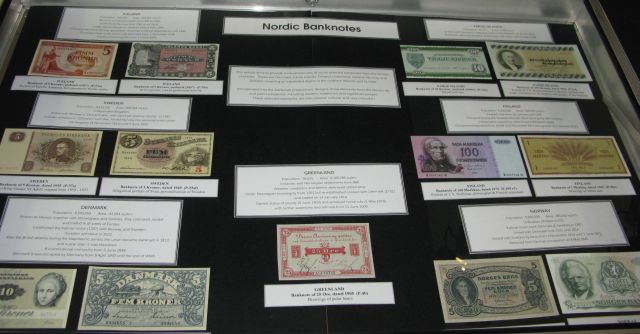
Melbourne Coin Club Member Displays. Photo courtesy SJS
One of Australia's top numismatists has just finished a series of informative pages on differentiating the die types of the Australian 5 cent.
From the very beginning of Australia's decimal history our very first 1966 five cent pieces were struck at 2 different Mint's, our own Royal Australian Mint in Canberra and the Royal Mint in London. In 1981 coins were struck at 3 different mints, the Royal Australian Mint, the Royal Mint in Llantrisant and the Royal Canadian Mint in Winnipeg.
More recently there have been die differences such as the high and low echidna varieties and the large, small and tiny SD, the initials of Stuart Devlin the coins' designer.
All these dies and variations are discussed in great detail on www.thesandpit.net website.
You can also find other informative numismatic articles and numismatic fun on the sandpit's site.


